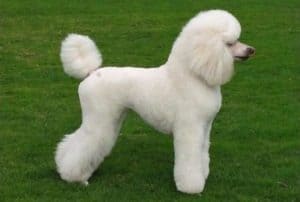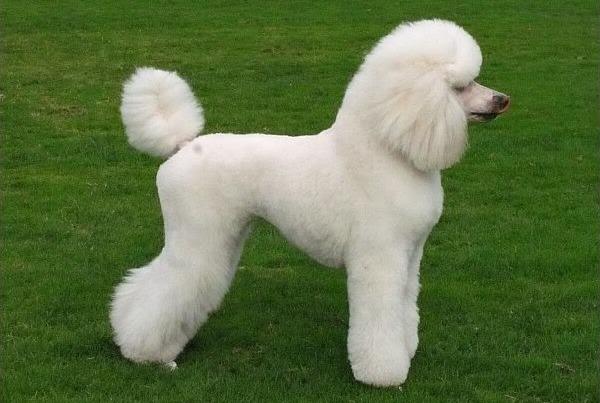The Dutch clip has been one of the most popular styles for pet Poodles for many decades. In the 1940s and 1950s, when it was truly in vogue, the legs were shaped into puffy pantaloons to create the effect of a Dutchman’s baggy trousers, thus the source of the name.
Here are the steps to achieve the Dutch clip:
- Bathe and fluff dry your Poodle.
- Follow the instructions for clipping the feet.
- Follow the instructions for clipping the face.
- Follow the instructions for clipping the tail.
- Sit the dog on the grooming table, facing you, to clip the back of the neck. Before beginning, you must decide how to shape the topknot at the nape of the neck: either rounded at the base of the skull, or into a V shape that converges down to a point in the center of the neck. If you choose to round the back of the topknot, hold the Poodle’s muzzle in your free hand, bend it down slightly, and place clippers at the base of the skull. Using a #15 blade, clip down to the point where the neck joins the body. Do not clip below that point. If you choose to make the V, scissor in the basic shape, proportioning the tip in the center of the neck according to its length, then clip around the V and down to the point where the neck joins the body. Clip the sides of the neck by lifting each ear and clipping down from under the ear to the same point on the other side.
- Clip the front of the neck with a #10 blade. If your Poodle is sensitive, however, and likely to scratch at his throat after clipping, use a #9 or #8-1/2. Pointing clippers upward, start an inch or so below the Adam’s Apple, and clip to the front of each ear. When the neck is completely clipped, the line from front to back looks like a necklace.
- Stand the Poodle with his hindquarters facing you to begin setting the pattern. The first step in setting the Dutch pattern is to clip a narrow strip from the tail straight up the center of the back to the neck. The mistake most beginners make is clipping the strip too wide; it should be about the same width as the base of the tail. To correctly propor
 tion the width of the strip to the variety of Poodle, use a #5/8 blade on a Toy, a #7/8 on a Miniature, and a #10 (or #15 if you like a closer clip) on a Standard. Start your clippers at the base of the tail and clip straight up the center of the back to the neck. Be sure your Poodle stands still while you clip the strip from tail to head. If the dog is fidgety, have someone steady his front so the strip is not off-center. If you are worried about making a straight line, clip halfway, from the base of the tail to the middle of the dog, then stop. Check to see that the clipped strip is straight. If it is, continue clipping the strip up to the neck. If it is not straight, make any minor adjustments, then continue.
tion the width of the strip to the variety of Poodle, use a #5/8 blade on a Toy, a #7/8 on a Miniature, and a #10 (or #15 if you like a closer clip) on a Standard. Start your clippers at the base of the tail and clip straight up the center of the back to the neck. Be sure your Poodle stands still while you clip the strip from tail to head. If the dog is fidgety, have someone steady his front so the strip is not off-center. If you are worried about making a straight line, clip halfway, from the base of the tail to the middle of the dog, then stop. Check to see that the clipped strip is straight. If it is, continue clipping the strip up to the neck. If it is not straight, make any minor adjustments, then continue. - The next step is to make a circular cut over the hindquarters on each side. Start at the center strip, about 1 to 2 inches forward of the hipbones and, with the same blade, clip a circular cut over the side of the dog. To assure balance and proportion, these measurements can be increased or decreased depending on the size of the dog. Then clip a strip on the other side of the dog that exactly matches the first side. Always start your circular cuts in front of the hipbones to keep the clipped line on the loins forward of the point where the back legs meet the body. The corners of the pattern lines should be slightly rounded with clippers.
- To complete the pattern, use the same blade to clip from the circular cuts on each side of the hindquarters forward, over the loin to the last rib. If you have clipped the stomach up to the last rib, the clipped line at the ribs now completely encircles the Poodle’s middle and the jacket is formed. Round off the corners of the pattern lines with your clippers.
- Once the body pattern has been set, be sure that all trimmed areas have been clipped to the same length, especially if you have used one of the narrow cutting blades to clip the center strip. When used against the growth of hair, these tend to cut close. For that professional finish, all clipped areas must look even and smooth.
- Stand the dog with his hindquarters facing you. Comb the hair on the back legs up and out to lift and fluff the coat. Follow the instructions for shaping and styling the back legs. Make both back legs even in size and shape.
- Comb the hair on the hips and hindquarters. Start at the top of the leg and scissor upward, blending the hair to flow smoothly into the hindquarters, following the natural contours of the dog’s body. When shaping the hair at the clipped strip and pattern lines over the hindquarters, fluff it up and out with your comb, then scissor off the untidy hair that falls over into the clipped areas to form precise and clean pattern lines. Then use curved shears to bevel, or slightly round, the edges all the way around the pattern, to remove any sharp lines and create a soft look.
- Now shape the front. Fluff out the hair on the jacket (the back, ribs, shoulders and chest) with your comb. Begin shaping by scissoring off any long hair that falls over the clipped strip and the pattern lines around the last rib. Next, bevel the edges all the way around the pattern to remove any sharp lines and create a soft look. Scissor the jacket to the same length as the hair on the hindquarters, following the natural contours of the body. Scissor the hair under the chest to the same length. Turn the dog to stand facing you, and shape the front of the chest slightly round, from shoulder to shoulder. Don’t leave too much hair here; it will only make the body look long and heavy. Comb the hair up at the clipped line around the neck. Scissor off any hair that falls over the clipped line to make the pattern look neat, then use curved shears to bevel the edges all the way around to remove any sharp lines.
- Have the Poodle stand facing you. Follow the instructions for shaping and styling the front legs.
- Sit the Poodle facing you. Comb the hair on the head upward and forward, and shape the topknot.
- Comb the ear feathering downward, then round the edges with scissors to remove any untidy hairs or excessive length for an overall balanced appearance.
There’s a few variation of the Dutch clip:
- the Chicago Dutch clip
- the Pittsburgh Dutch clip
- the Criss-Cross Dutch clip
- the Pajama Dutch clip
How to Achieve a Dutch Clip For a Poodle was last modified: April 14th, 2020 by zsoltm1778

